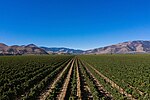Arroyo Seco AVA

Arroyo Seco is an American Viticultural Area (AVA) in Monterey County, California, southeast of Monterey Bay. The appellation encompasses 18,240 acres (29 sq mi) in the valley adjacent to the Arroyo Seco Creek with approximately 8,500 acres (3,440 ha) of cultivation. The region's proximity to the Pacific Ocean produces the maritime climate, and is best suited for those cool climate grape varieties. The soils in the Arroyo Seco area consist of a series of gravelly and fine sandy loams well suited to the cultivation of grapes. The viticultural area is an alluvial fan formed by well drained soils with slopes ranging from 0 to 9 percent. Principal soil series include Mocho, Lockwood, Arroyo Seco, Rincon, Elder, and Chular. The prominent soils, Chular and Arroyo Seco, are coarse sandy loams derived from decomposed granite washed down from the Gabilan Range. These soils are gravelly and low in lime content similar to the vineyards in the Medoc and Graves districts of Bordeaux, and to the better vineyards in the Palatinate
Excerpt from the Wikipedia article Arroyo Seco AVA (License: CC BY-SA 3.0, Authors, Images).Arroyo Seco AVA
Paraiso Springs Road,
Geographical coordinates (GPS) Address Nearby Places Show on map
Geographical coordinates (GPS)
| Latitude | Longitude |
|---|---|
| N 36.34154178 ° | E -121.34127273 ° |
Address
Paraiso Springs Road
Paraiso Springs Road
California, United States
Open on Google Maps



